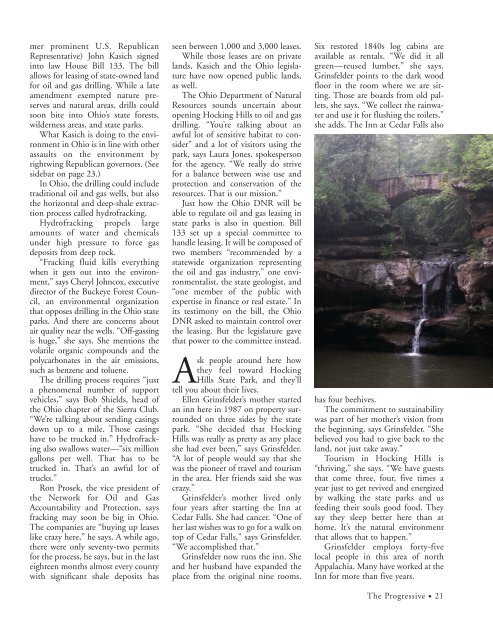Jodie Evans
Jodie Evans
Jodie Evans
Create successful ePaper yourself
Turn your PDF publications into a flip-book with our unique Google optimized e-Paper software.
mer prominent U.S. Republican<br />
Representative) John Kasich signed<br />
into law House Bill 133. The bill<br />
allows for leasing of state-owned land<br />
for oil and gas drilling. While a late<br />
amendment exempted nature preserves<br />
and natural areas, drills could<br />
soon bite into Ohio’s state forests,<br />
wilderness areas, and state parks.<br />
What Kasich is doing to the environment<br />
in Ohio is in line with other<br />
assaults on the environment by<br />
rightwing Republican governors. (See<br />
sidebar on page 23.)<br />
In Ohio, the drilling could include<br />
traditional oil and gas wells, but also<br />
the horizontal and deep-shale extraction<br />
process called hydrofracking.<br />
Hydrofracking propels large<br />
amounts of water and chemicals<br />
under high pressure to force gas<br />
deposits from deep rock.<br />
“Fracking fluid kills everything<br />
when it gets out into the environment,”<br />
says Cheryl Johncox, executive<br />
director of the Buckeye Forest Council,<br />
an environmental organization<br />
that opposes drilling in the Ohio state<br />
parks. And there are concerns about<br />
air quality near the wells. “Off-gassing<br />
is huge,” she says. She mentions the<br />
volatile organic compounds and the<br />
polycarbonates in the air emissions,<br />
such as benzene and toluene.<br />
The drilling process requires “just<br />
a phenomenal number of support<br />
vehicles,” says Bob Shields, head of<br />
the Ohio chapter of the Sierra Club.<br />
“We’re talking about sending casings<br />
down up to a mile. Those casings<br />
have to be trucked in.” Hydrofracking<br />
also swallows water—“six million<br />
gallons per well. That has to be<br />
trucked in. That’s an awful lot of<br />
trucks.”<br />
Ron Prosek, the vice president of<br />
the Network for Oil and Gas<br />
Accountability and Protection, says<br />
fracking may soon be big in Ohio.<br />
The companies are “buying up leases<br />
like crazy here,” he says. A while ago,<br />
there were only seventy-two permits<br />
for the process, he says, but in the last<br />
eighteen months almost every county<br />
with significant shale deposits has<br />
seen between 1,000 and 3,000 leases.<br />
While those leases are on private<br />
lands, Kasich and the Ohio legislature<br />
have now opened public lands,<br />
as well.<br />
The Ohio Department of Natural<br />
Resources sounds uncertain about<br />
opening Hocking Hills to oil and gas<br />
drilling. “You’re talking about an<br />
awful lot of sensitive habitat to consider”<br />
and a lot of visitors using the<br />
park, says Laura Jones, spokesperson<br />
for the agency. “We really do strive<br />
for a balance between wise use and<br />
protection and conservation of the<br />
resources. That is our mission.”<br />
Just how the Ohio DNR will be<br />
able to regulate oil and gas leasing in<br />
state parks is also in question. Bill<br />
133 set up a special committee to<br />
handle leasing. It will be composed of<br />
two members “recommended by a<br />
statewide organization representing<br />
the oil and gas industry,” one environmentalist,<br />
the state geologist, and<br />
“one member of the public with<br />
expertise in finance or real estate.” In<br />
its testimony on the bill, the Ohio<br />
DNR asked to maintain control over<br />
the leasing. But the legislature gave<br />
that power to the committee instead.<br />
Ask people around here how<br />
they feel toward Hocking<br />
Hills State Park, and they’ll<br />
tell you about their lives.<br />
Ellen Grinsfelder’s mother started<br />
an inn here in 1987 on property surrounded<br />
on three sides by the state<br />
park. “She decided that Hocking<br />
Hills was really as pretty as any place<br />
she had ever been,” says Grinsfelder.<br />
“A lot of people would say that she<br />
was the pioneer of travel and tourism<br />
in the area. Her friends said she was<br />
crazy.”<br />
Grinsfelder’s mother lived only<br />
four years after starting the Inn at<br />
Cedar Falls. She had cancer. “One of<br />
her last wishes was to go for a walk on<br />
top of Cedar Falls,” says Grinsfelder.<br />
“We accomplished that.”<br />
Grinsfelder now runs the inn. She<br />
and her husband have expanded the<br />
place from the original nine rooms.<br />
Six restored 1840s log cabins are<br />
available as rentals. “We did it all<br />
green—reused lumber,” she says.<br />
Grinsfelder points to the dark wood<br />
floor in the room where we are sitting.<br />
Those are boards from old pallets,<br />
she says. “We collect the rainwater<br />
and use it for flushing the toilets,”<br />
she adds. The Inn at Cedar Falls also<br />
has four beehives.<br />
The commitment to sustainability<br />
was part of her mother’s vision from<br />
the beginning, says Grinsfelder. “She<br />
believed you had to give back to the<br />
land, not just take away.”<br />
Tourism in Hocking Hills is<br />
“thriving,” she says. “We have guests<br />
that come three, four, five times a<br />
year just to get revived and energized<br />
by walking the state parks and us<br />
feeding their souls good food. They<br />
say they sleep better here than at<br />
home. It’s the natural environment<br />
that allows that to happen.”<br />
Grinsfelder employs forty-five<br />
local people in this area of north<br />
Appalachia. Many have worked at the<br />
Inn for more than five years.<br />
The Progressive u 21



